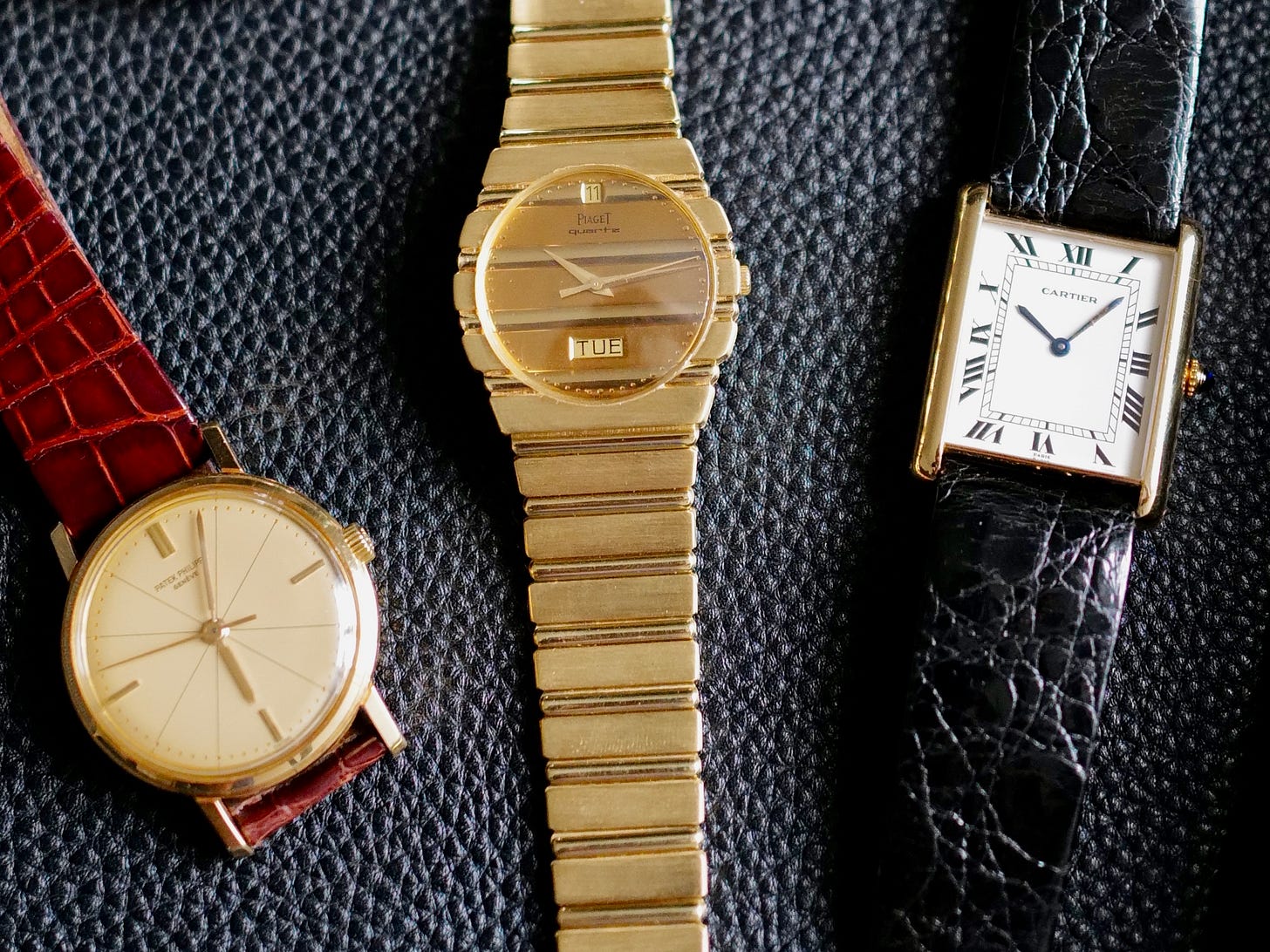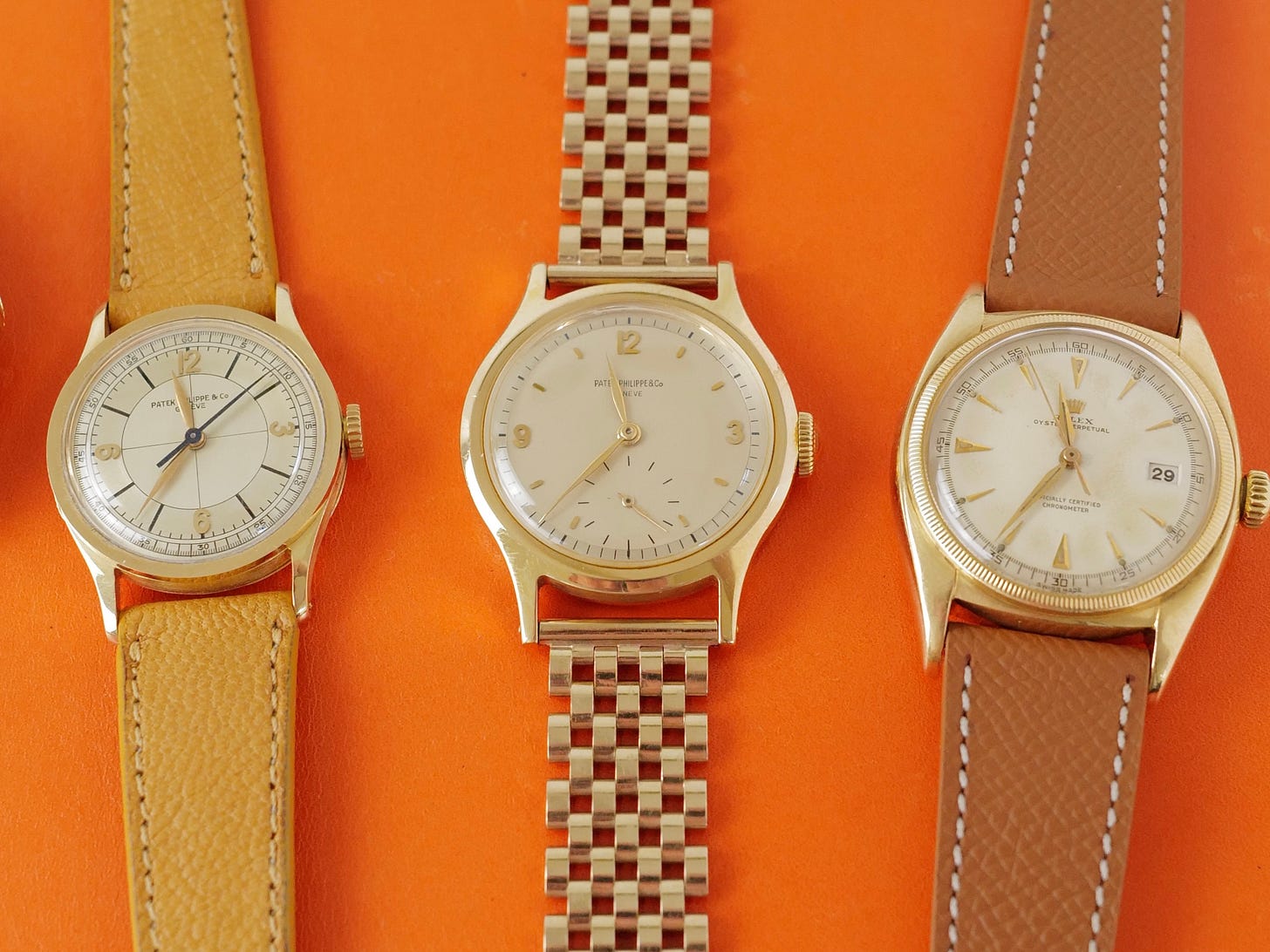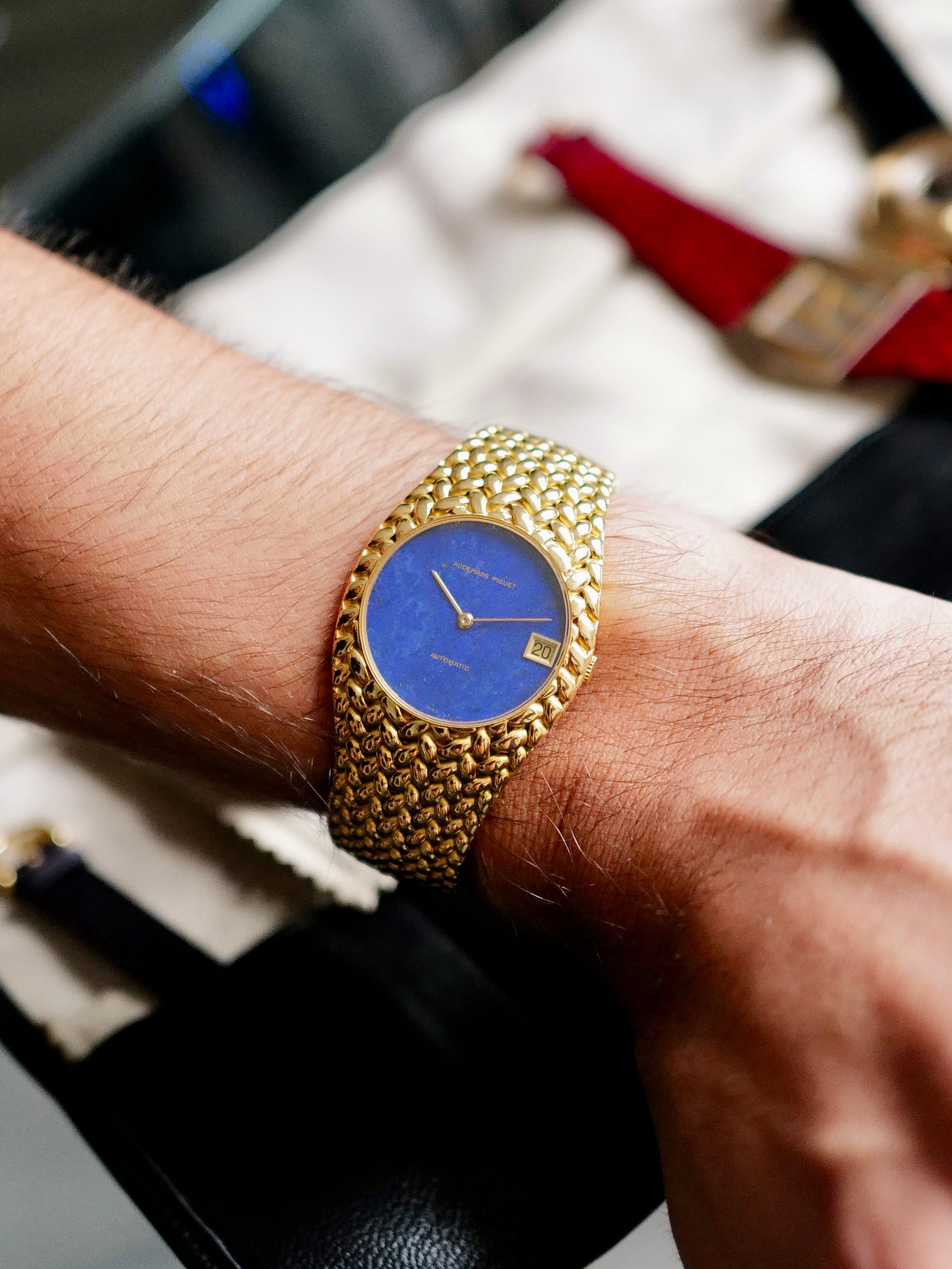Inside the UK's vintage watch scene
A conversation with two heavy-hitting collectors about all things time piece collection.
A quick note
Our London correspondent, Cody McKim — who has previously covered the city’s independent tailored clothing scene, sits down with two veteran vintage watch dealers based in the UK: Alex Stevens of Alex Stevens Vintage, and Robin Mann of Mann About Time.
They chat about everything from the relationship between style and watches to advice for buying your first (or fifth) vintage piece and some under-the-radar references that still feel like hidden gems.
Huge thanks to Cody for his photography in this piece as well as guiding questions for the interview. Give him a follow!
On getting into the game
Alex and Robin — thanks for sitting down with me, having exchanged a few watches with you both before, I knew I was keen to get your perspective on the current state of the vintage world, especially from where we sit in the UK.
But first, why don't you tell readers a bit more about yourselves and how you got here?
AS:
I grew up tagging along with my dad, a bookseller and collector, to local car boot sales, charity shops, and auctions. I also religiously watched Bargain Hunt and Flog It! as a kid.
The bug clearly bit early, because by the time I was 14, I was buying and selling anything that caught my eye (or that I thought I could flip for a profit) on eBay. I dabbled in cufflinks, pens, clothes, prints, bicycles — you name it. Then I stumbled across some old watches, did well with them, and that’s where it all started.
By 16, I decided to specialise, and after leaving school, I took an apprenticeship at a vintage watch specialist and auction house in London to really learn the craft. After that, I went solo.
I’ll turn 28 this summer, which is wild to think about — it means I’ve been doing this for over half my life! These days, I spend every waking hour hunting for watches and curating a carefully vetted selection for my website and Instagram. Behind the scenes, I also run a wholesale side of my business, selling watches to other dealers, retailers, and shops.
RM:
My background is actually in art. I came to London over 20 years ago to study art history, and from there started running a contemporary space in Soho, which eventually led to opening a gallery with my (now) wife.
Art’s still a big passion of mine, but throughout my twenties, I also quietly bought and sold vintage watches, mostly mid-century Omega.
As the art world started to change—and I became a bit disillusioned with where it was heading—my wife (who could see where my heart really was) encouraged me to go all in on watches. And, over a pint in the pub, Mann About Time was born.
It was the best decision I could have made. I feel lucky to do what I truly love for a living.
On who's buying vintage watches today
Love that you both came into this in your own way and still enjoy it so much after all these years. Since you’ve been around the space for a while, how has the demographic of vintage watch buyers changed recently?
AS:
When I started out, the vintage scene was dominated by men over 40 or 50, and that was reflected in the customer base. But over the last decade, interest from younger generations has surged, and the average buyer has gotten noticeably younger.
Many of my customers today are first-time buyers, which I really enjoy—it’s rewarding to guide someone as they start their collection.

On advice for new collectors
That evolution is exciting to see. For someone looking for their first vintage watch—or already deep into building a collection—what’s a piece of advice you think is often missed in articles or videos? And how does the UK market compare to the US?
AS:
There’s so much content online now—YouTube, TikTok, Instagram, blogs—it’s easy to get overwhelmed. But we have to remember: these are tactile objects. You need to handle them to really understand them.
I always tell early collectors to get hands-on. Go to auction previews, events, and meet-ups. Learn what you’re drawn to. Then, once you’ve got that foundation, you can move back online to actually buy.
In 2025, the internet is still the best place to purchase vintage watches.
The UK market, being a small island, is unique. We don’t have the same wealth that the US or mainland Europe enjoys. Fewer pieces turn up here, and while there is a vintage watch “scene,” it’s relatively small and closed.
Fewer big dealers, fewer collector gatherings.
Brexit didn’t help either—20% duties apply to most imports now, which makes things harder. But oddly, that’s strengthened the local market. More Brits are buying from Brits to avoid those fees. Still, over half my sales go to the US. It remains my biggest market by far.
RM:
One thing that still irks me is the obsession with box and papers. I get so many questions about whether a 60- or 70-year-old watch comes with its original extras. Jasper from AVW recently called out how futile this can be—those extras are often cobbled together, or worse, faked.
I’ve heard of dealers tucking papers into antique books to give them an “authentic” smell. All to hike the price for unsuspecting buyers.
The truth? Condition is king. Buy the best example you can afford—and always from a trusted source. If the watch comes from the original owner or a reputable dealer and happens to include the extras, great. But for vintage, that should be the last thing on your checklist.
On style, sizing, and shifting tastes
Alex, your taste—and the watches you sell—leans more dressy. Robin, I’d say you nod more toward tool and sport watches, but I love that you both advocate for breaking style rules.
Robin, you’ve talked about pairing a gold dress watch with a tee and denim. Are your buyers reflecting that mindset too? Is demand tapering for smaller, dressier models?
AS:
Actually, demand for dress watches has never been higher in my time. The rise of vintage Cartier—especially the Tank, which I sell a lot of—has driven that. And in today’s world of rampant watch theft (especially in Europe), buyers are gravitating toward more understated, discreet options.
How people style these watches has changed too. That gold dress piece that once came out only for tuxedos? Now it’s worn with a tee or streetwear, stacked with bangles and bracelets.
Celebrity influence plays a big role—guys like Tyler, The Creator and Timothée Chalamet have made smaller Cartiers feel fresh and cool again.
RM:
I wouldn’t say demand for smaller models is dropping—far from it. If anything, I wish modern watchmakers would stop making boats for the wrist!
Sizes that were once considered “too small”—30mm, say—are now gaining appreciation. Think Patek 96s or Rolex Bubble Backs.
They’ve long flown under the radar, or sat quietly in smart collections. The challenge now is finding a clean, original example.
Many were over-restored in the ’90s, so true survivors are few and far between. But that’s part of the thrill—those Christmas-morning moments when a gem pops up are what keep me going.
As for stone dials or jewelry-style watches, that’s not really my thing, and I’ve seen that frenzy settle down a bit. I keep my focus tight.
But precious metals and unique case shapes are having a moment, and collectors are clearly looking for watches that don’t match what their neighbor’s wearing. I love that—it keeps the scene more interesting.
And yeah, I’m a denim and white tee guy too. Whether it’s a ’60s Daytona or a gold Patek 96, a good vintage watch just works. In my opinion, if you care about style, you care about your shoes—and your watch. They can make or break an outfit.

What's the deal with stone dials?
So... less hype around those wild stone dials we’ve seen in recent years?
AS:
I’d say that market has leveled off, but stone dials are still in demand—and finally getting the recognition they deserve. They’re beautiful, rare, and high quality, which are the three magic ingredients when it comes to desirability.
Condition is critical. I won’t touch cracked examples. I once bought a pristine jadeite Piaget that cracked during shipping. They're delicate, so beware!
If you're curious, Dennison recently launched some handsome stone-dial watches for under £600. I have one myself—it gets a lot of wrist time.
RM:
Definitely leveling out. Piaget stone dial prices shot up quickly, but they were arguably too cheap for too long. Bargains existed not long ago, but things feel a bit “toppy” now.
That said, a clean stone dial Day-Date with no flaws will always command strong prices. And again—it all comes down to condition and the trustworthiness of the seller. Stick to those rules, and you’re unlikely to overpay.
Most worn watch of the past year?
AS:
My Cartier London Tank. I wore it nearly every day until late 2024, when I sold it to a great collector in the States. I was sad to see it go, but it was the right moment. Cartier London watches are highly coveted now—and rightly so. In my opinion, they represent the pinnacle of Cartier’s output.
It’s both amazing and a bit painful to think about what I used to buy and sell them for just five or six years ago.
RM:
My Rolex Daytona Reference 6239. It’s a personal piece that I’ll never part with. For me, it’s about as close to perfection as it gets.
On thinking about style and daily wear
When you’re getting dressed, do you think about how your watch complements your personal style? And do clients ask for advice on matching their watch to their wardrobe?
AS:
The true icons are incredibly versatile. A vintage Calatrava, Daytona, or Tank looks just as good styled with a jumper for a Sunday roast as it does with a dinner jacket at an event.
Most customers already know what fits their style, so I don’t get asked that too often—unless it’s advice for a specific project, like a film or photoshoot.
RM:
I’m lucky—most of my clients are already confident and refined in their style, so I don’t need to interfere!
For my own wardrobe—think heritage wear, lots of Drake’s and Ralph Lauren, and (far too many) visits to Clutch Café in London—a vintage watch always fits right in. The real question isn’t which watch will work, but rather: which one am I willing to sacrifice and leave in the safe today?






The Dennison stone watches are a cool tip. I like the malachite.